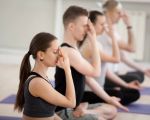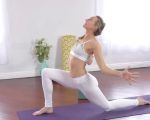Tips for Mastering Challenging Yoga Poses: A Guide for Advanced Yogis
- 1 - Understanding the Challenge of Difficult Yoga Poses
- 2 - The Importance of Breathing in Difficult Poses
- 3 - Building Strength and Flexibility for Mastery
- 4 - Using an Incremental Approach to Progress
- 5 - The Role of Mental Focus and Mindfulness
- 6 - Consistency and Patience: The Keys to Success
1 - Understanding the Challenge of Difficult Yoga Poses
Mastering challenging yoga poses can feel daunting, especially for those looking to progress beyond basic postures. These advanced asanas require not only physical strength and flexibility but also mental focus and alignment awareness. However, the difficulty of these poses lies in their complexity, combining multiple factors such as balance, coordination, and endurance. The goal is not to achieve perfection immediately but to embrace the learning process and gradually improve your form.
One of the first steps to mastering challenging yoga poses is understanding what makes them difficult. Often, these poses require a combination of balance, flexibility, strength, and sometimes, core stability. For example, poses like Scorpion Pose or Handstand demand core strength and upper body control, while others like King Pigeon Pose require deep hip flexibility. As you encounter these challenges, it’s important to remember that mastery in yoga doesn’t come overnight—patience and practice are essential.
2 - The Importance of Breathing in Difficult Poses
One of the most essential tips for mastering challenging yoga poses is the focus on breathing. Your breath serves as the foundation for every yoga pose, especially the more difficult ones. Deep, controlled breathing ensures that you stay calm, focused, and steady, preventing tension in the body and helping to maintain balance during challenging poses.
In many advanced asanas, it’s common to hold your breath due to the intensity of the pose or the effort it requires. However, breath retention can cause unnecessary tension, making the pose more difficult. Instead, focus on long, even inhales and exhales to guide your movements. For instance, when attempting Forearm Stand, breathing steadily as you engage your core and press your arms into the mat will help maintain alignment and avoid collapsing or wobbling. Breathing helps you focus, align, and stabilize, so make it a priority during every session.
3 - Building Strength and Flexibility for Mastery
Advanced yoga poses often require a balance of strength and flexibility. Strength is needed to support the body in positions that challenge your endurance, while flexibility allows your body to move fluidly into deeper stretches or twists. Both are crucial to successfully mastering difficult yoga poses.
To build the necessary strength, incorporate poses such as Plank, Chaturanga, and Warrior III into your practice. These poses engage your core, arms, and legs, which are all essential for supporting advanced asanas like Wheel Pose or Handstand. Likewise, for flexibility, poses such as Forward Fold, Low Lunge, and Butterfly can help you open up the hips, hamstrings, and lower back, which are key for deeper poses.
It's important to remember that flexibility and strength should be developed gradually and safely. Overstretching or overexerting yourself can result in injury. Take the time to listen to your body and only progress when you feel confident and strong enough to do so.
4 - Using an Incremental Approach to Progress
Trying to jump straight into a difficult yoga pose without preparation can often lead to frustration or even injury. The key to mastering challenging poses is to take an incremental approach. Start by practicing the foundational poses that lead to more advanced asanas, and gradually increase the intensity as your strength and flexibility improve.
For example, if you're aiming to master King Pigeon Pose, you can begin with basic hip-openers like Low Lunge and Pigeon Pose to gradually increase flexibility. Similarly, for inversions like Headstand, it’s important to first build shoulder stability with poses like Downward Dog and Plank before attempting the full pose. This incremental approach allows you to prepare your body and mind for the more complex demands of the challenging poses, making your practice safer and more effective.
5 - The Role of Mental Focus and Mindfulness
Yoga is not just about the physical body—it’s also a practice of the mind. When it comes to mastering challenging yoga poses, mental focus and mindfulness play a significant role in your success. Advanced poses often require more than just physical ability; they demand concentration and presence in the moment.
Being mindful of your body alignment, breath, and sensations helps you stay grounded and avoid the common mistake of pushing too hard. Focusing on the present moment helps eliminate distractions, and this is particularly important when attempting poses like Arm Balances or Backbends, where precision and control are critical. Visualizing success before attempting a pose and mentally preparing yourself for the effort can also enhance your performance.
Many experienced yogis recommend using meditation techniques before or after practice to enhance mental focus and clarity. Regular meditation can help calm the mind, reduce anxiety, and improve concentration, all of which are key to successfully executing difficult poses.
6 - Consistency and Patience: The Keys to Success
One of the most important tips for mastering challenging yoga poses is maintaining consistency in your practice. Yoga, especially advanced poses, requires ongoing effort, practice, and patience. Even the most seasoned yogis don’t perfect challenging poses overnight, and you shouldn’t expect to either. Consistency in your practice ensures that your body adapts to the demands of each pose, gradually building the strength and flexibility necessary to perform them effectively.
Patience is equally important. Yoga is a journey, not a destination, and each practice is a step toward improvement. Celebrate small victories along the way, whether it’s getting deeper into a stretch or holding a challenging pose for a few extra seconds. These small moments of progress are significant and will keep you motivated as you continue to work toward mastering difficult poses.
At Free Yoga Links, we provide resources and support to help you stay on track with your yoga journey. Whether you’re looking for guided classes, yoga accessories, or personalized advice, we’re here to assist you in your practice.








